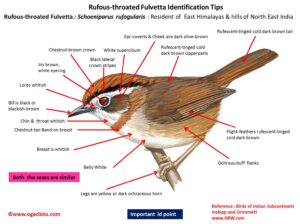
Rufous-throated Fulvetta Schoeniparus rufogularis
Etymology:
- Schoeniparus : latin word schoenus –rush, reed; parus- tit.
- Rufogularis : Latin word rufus red; gularis –throated { Red throated}
- Collaris : Latin word for “neck” derived from collum – neck
Distribution in India: Eastern Himalayas, Hills of North East India.
- Nominate – North East India (Jalpaiguri, in West Bengal, Arunachal Pradesh) and Bhutan
- S.r. collaris – North East India ( Arunachal Pradesh , Meghalaya, S Assam, Nagaland and Manipur)
Description: Size of 12–13 cm. it is a small, neat babbler with chestnut cap bordered by bold black and white stripes, and chestnut throat band. The nominate race has crown to nape chestnut-brown, black lateral crownstripe. The white supercilium starting on, respectively, forehead and lores and running back over dark olive-brown ear-coverts. The upperparts, upperwing and tail are rufescent-tinged cold dark brown. The chin, throat, submoustachial area and adjacent tufts below ear-coverts are white. The neck side is chestnut-tan, this colour continuing in band across lower throat and upper breast. The breast to belly is white, breast side is greyish, shading to ochrous-buff on flanks and ochre on vent. The iris is brown; bill is black or blackish-brown; legs are yellow or dark ochraceous horn. Both the sexes are similar.
Race collaris has darker crown and more rufescent upperparts than nominate, flanks more heavily washed with brown
Habitat: It is found in primary, logged and secondary broadleaf evergreen and semi-evergreen forest, second growth, scrub, bamboo brakes. It is found up to 900 m in India.
Food habits: It eats small invertebrates. It is found singly or in pairs, or in small parties outside breeding season; rarely with mixed-species flocks. It forages in dense cover close to or on ground. It is shy and secretive.
Breeding habits: They breed in Mar–Jun in India. The nest is a rather loose dome or semi-dome or cup on large base of leaves, protected by whorl of upward-pointing leaves, made of dead bamboo or other leaves, grass, roots, moss and tendrils, lined with rootlets, placed on ground, in bottom of bush, in tangle of creeper above ground in fork of small sapling. They lay a clutch of 3–4 eggs.